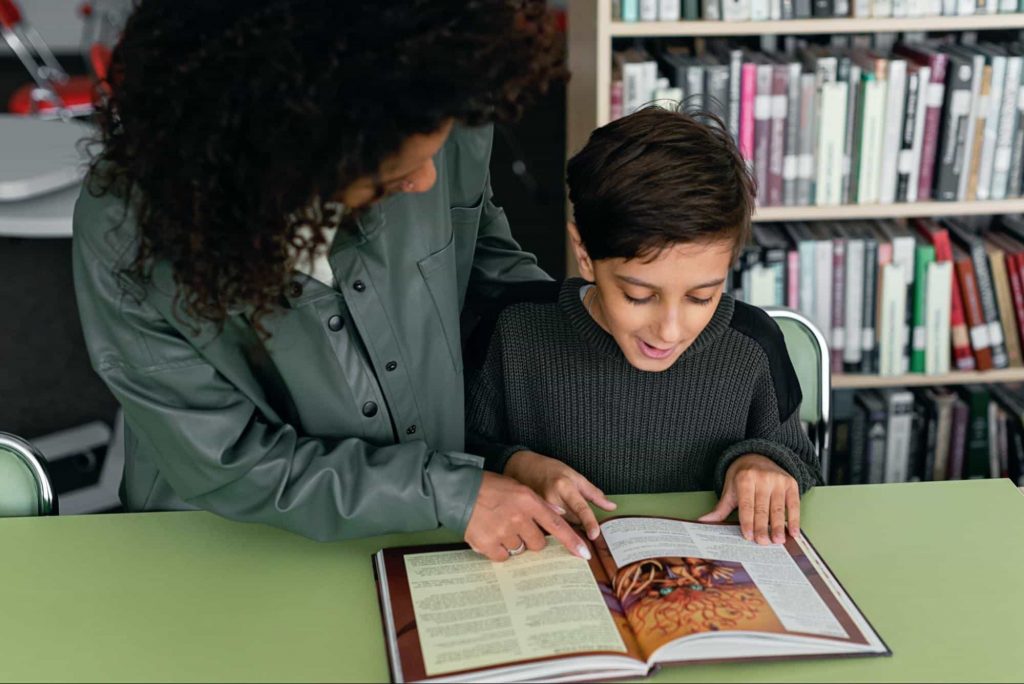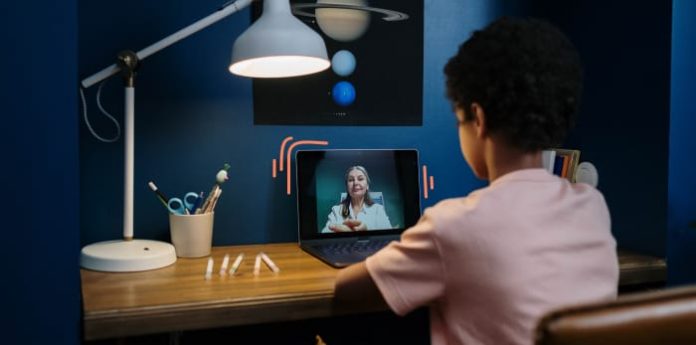Synchronous and asynchronous learning are two popular learning modules. As the name suggests, synchronous learning means learning in a class from teachers. In contrast, asynchronous allows students to learn independently, like peer-to-peer activities.
Math & ELA | PreK To Grade 5
Kids see fun.
You see real learning outcomes.
Watch your kids fall in love with math & reading through our scientifically designed curriculum.
Parents, try for free Teachers, use for free
Teaching faculties have always debated the benefits of both learning environments. However, since the pandemic has brought seismic shifts to both learning systems, the debate has heated up again.
This post will talk about synchronous learning in-depth and see how it can benefit students and teachers.
What is Synchronous Learning?

Synchronous learning is a type of education and learning that happens simultaneously but not necessarily in the same place. It is a form of distance learning where students learn from different locations via digital modes like televisions, video lessons, etc.
Related Reading: Indoor Learning Activities for 1 Year Olds for Endless Fun at Home
Synchronous learning can take place both offline and online. Teachers can ask students to work on the assignment simultaneously in a physical or virtual classroom.
Traditionally, students come together and sit with an instructor to gather knowledge in a synchronous learning environment. Due to COVID-19, the synchronous learning process has turned virtual. Now, teachers use different online learning tools to teach students simultaneously, despite their physical locations.
How to Use Synchronous Learning in Your Classroom?

Instructors can use synchronous learning in their classrooms via offline and online approaches. Here are a few use cases of synchronous learning:
1. Live classroom
The regular classroom experience is a standard synchronous learning example. When you teach a group of students in a classroom at the same time, this is the best demonstration of synchronous learning. Live classrooms help teachers gauge real-time reactions from students through their facial and hand expressions.
2. Hand-on training
Instead of lectures, you can teach your students by presenting them with a problem and solving it in a natural environment. It is practical training that allows students to use their creativity and bounce new ideas to solve problems. For example, history teachers can take their classes to museums and show them historical facts rather than teach from an introductory textbook.
3. Guest lectures
You can invite professionals to give a lecture to your class. Through physical class visits or video conferencing, let your students ask questions from different professionals to enhance their knowledge bank.
4. Online learning
It is similar to the live classroom. But, the only difference is that teachers and students are present in different locations connected via virtual tools. Teachers can provide one-on-one lessons in synchronous learning, and students can find answers in real-time, similar to traditional classrooms. This learning method has become a lot more common after the pandemic.
Teachers can also use online learning platforms like SplashLearn and teach through fun games & worksheets. Register today and use it for free!
5. Webinars
Webinars are helpful when an instructor has to provide a virtual lecture to many participants. In webinars, instructors have only the right to speak, whereas learners can ask questions via text that instructors will answer at the end. Instructors can use slides, presentations, and other visual elements to make lectures interesting.
6. Live streaming
This is the most fun synchronous learning method. In this approach, learners are taken outside the class and taught in an interactive environment. For example, educators can go live on Facebook or Instagram to teach new things to their followers. In return, they can ask for donations or shares from their viewers.
7. Surveys and polls
Using the virtual learning tools, teachers can conduct surveys and polls. This helps teachers understand the viewpoint of students. It can be further helpful to design engaging and informative lessons for teachers.
How Can Synchronous Learning Benefit Teachers?

Synchronous learning can benefit teachers in both offline and online learning setups. Using synchronous learning techniques, you can gain several benefits, such as:
1. Structured learning
Synchronous learning gives you the benefit of providing structured lessons to your class. This allows teachers to design a proper lesson to help students learn at their own pace. This structure will help keep learners on track and avoid situations where particular learners struggle to follow the lessons.
2. Real-time feedback
When students and teachers are present in a moment, it is easier for students to ask questions and receive real-time answers from their teachers. Students can raise their hands in the middle of a lesson to ask questions if they don’t understand anything. This will fasten up the learning process as teachers can clear students’ doubts during the class.
3. Collaborative learning
Synchronous learning environments build collaboration between students and teachers. Students feel like they are a part of a community. This provides them with confidence to freely express their thoughts and help classmates with their studies.
4. Engaging learning
Synchronous learning techniques also help to increase students’ engagement in the classroom. Teachers can use blackboards, hand gestures, and other tools to immerse students in a lesson. Being face-to-face also allows teachers to observe students and make changes in the curriculum if they find students disengaged at any point.
5. Direct instructions
One of the most significant benefits of synchronous learning is that teachers can provide direct instructions to students. They can easily explain concepts to a group and clear their doubts in real-time. Also, teachers can observe students’ behavior and facial features to understand whether they understood a concept or not.
6. Teach at scale
Through synchronous e-learning methods like webinars, you can teach many people at once. Webinars are the best way to teach a more vast audience using interactive tools like polls, slides, presentations, and more. It will save instructors time and give them sufficient time to create an interactive curriculum or lessons.
7. Improve learning standards
In the end, we all measure learning methods’ success based on the improvement in the classroom learning level. And synchronous learning is instrumental in improving learning standards. It allows students and teachers to interact in real-time. This way, teachers can make instant changes in the curriculum if they find students struggling.
8. Learn from anywhere
This is the significant advantage of online learning. Students can learn from anywhere using their desktops and mobile devices. Nowadays, tools like Zoom and Google Classroom facilitate students to join virtual classrooms from anywhere. This is handy for physically incapable and other students who can’t travel for education.
Related Reading: Best Learning Activities for 2-Year-Olds Every Parent Must Try Once
Ideas for Synchronous Learning Sessions

If it is your first time creating synchronous sessions, here are a few ideas to help you out:
- Involve students in the process. Use polls and surveys to request students share their input to make synchronous lessons more informative and engaging.
- Use lunch breaks and playground time for peer-to-peer teaching. Request students to discuss their doubts or have an academic discussion during their free period.
- Allow students to share their ideas and concerns via different modes like audio, videos, etc.
- Use cloud-based tools like Google Docs to incubate virtual collaborative learning.
- Collect micro feedback from your students to improve the teaching level in your classroom.
- Collaborate with other teachers in your school to give guest lectures in one another’s class.
- Engage students in an activity. For example, to develop empathy among your students, take them to orphanages, old age homes, etc.
- Divide your class into two groups to host a debate on the topic.
Bottom Line
Synchronous learning is one of the best learning modules today that can work in both online and offline education systems. It allows teachers to build a healthy relationship with students and teach them in real-time.
Teachers can better engage, understand and improve education level with synchronous learning. As we have already explained the benefits and uses of synchronous learning, we now request teachers to give a short to it and achieve great results.
Related Reading: Best & Important Character Traits for Kids That All Parents Must Instill
Frequently Asked Questions (FAQs)
What are synchronous learning activities?
Synchronous learning activities are learning activities that help students learn something new in a well-structured manner. Some online/offline synchronous learning examples are live chatting, video conferencing, telephonic conversations, etc.
What is the best solution to make synchronous learning lessons engaging?
Teachers can use synchronous learning techniques in different manners to make engaging lessons. However, the lesson that includes posing a question and giving participants a moment to write is the most engaging one. Alternative to posing questions, you can ask random questions from students and give them a few minutes to write down their answers.
What are synchronous learning tools?
Synchronous learning tools help teachers create a virtual classroom and interact with students in real-time. The common synchronous learning tools are video conferencing software, learning management systems, webcams, etc.
How to improve synchronous learning standards in your classroom?
Here’s how you improve synchronous learning standards in your classroom:
- Split your large class into smaller groups to better engage with each student.
- Send a preparation task for students to do before class.
- Give homework to students after the class to follow up lessons.
- Request students to keep their web cameras and microphones on during the class.
- Do a social check-in at the beginning of class, like exchange pleasantries or mark their attendance.
- Tell students what to expect during the lesson.
























